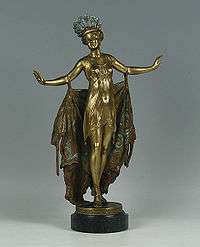Franz Xaver Bergmann

Franz Xaver Bergman (or Franz Xaver Bergmann) (1861–1936) was the owner of a Viennese foundry who produced numerous patinated and cold-painted bronze Oriental, erotic and animal figures, the latter often humanized or whimsical, humorous objects d'art.
Early life and career
Bergmann was noted for his detailed and colorful work. He signed with either a letter 'B' in an urn-shaped cartouche or 'Nam Greb' – 'Bergman' in reverse.[1] These marks were used to disguise his identity on erotic works.
His father, Franz Bergmann (1838–1894),[1] was a professional chaser from Gablonz who came to Vienna and founded a small bronze factory in 1860. Franz Xaver Bergmann inherited the company and opened a new foundry in 1900. Many of the bronzes from the 1900s were still based on designs from his father's workshop.
Bergmann is often incorrectly described as a sculptor but he was not; he was a foundry owner. His workshops employed, on a temporary basis, many anonymous sculptors. Bruno Zach employed Bergmann to edit and cast some of his works,[2] with some of the more erotic ones being signed as "Prof. Tuch", a pseudonym used by Zach. At the turn of the 19th century there were about fifty workshops producing Vienna bronzes.
'Cold-painted bronze' refers to pieces cast in Vienna and then decorated in several layers with so-called dust paint; the know-how for the mix of this kind of paint has been lost. The color was not fired hence 'cold painted'. The painting was carried out mainly by women working at home, a typical cottage industry.
Sensuous poses of young women in the Art Nouveau style were disguised by a covering that revealed all when a button was pushed or a lever moved. Often carefully sculpted animals, such as bears, could be opened to reveal an erotic figure inside.
Foundry closure
The Bergmann foundry was closed in 1930 due to the Great Depression. It was reopened some years later by Robert Bergmann, son of Franz, and operated until his death in 1954 when the remaining stock and molds were sold to Karl Fuhrmann & Co.[1]
Foundry seal
Death
Franz Bergmann died in 1936.[1]
References
External links
| Wikimedia Commons has media related to Franz Xavier Bergman. |